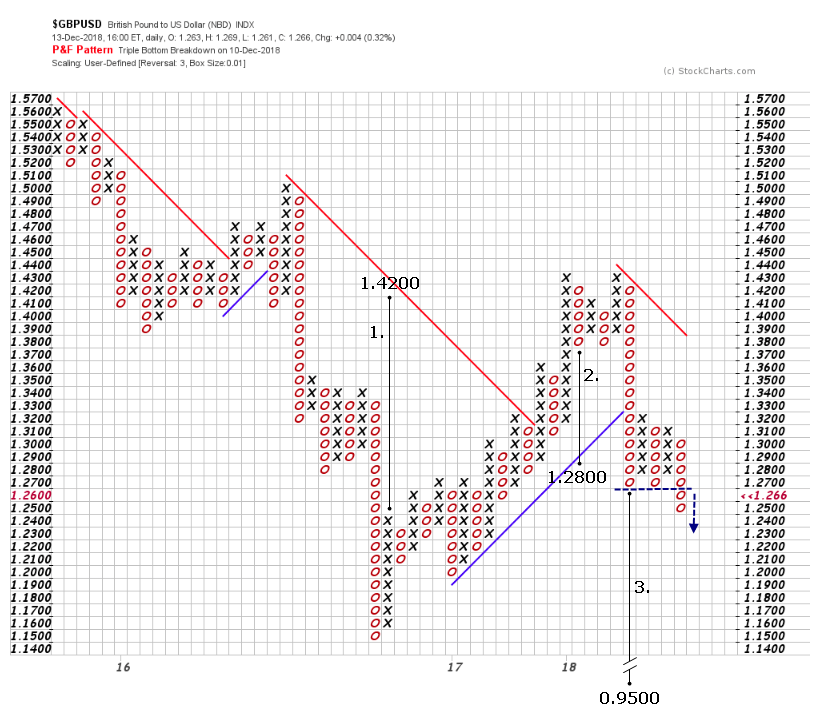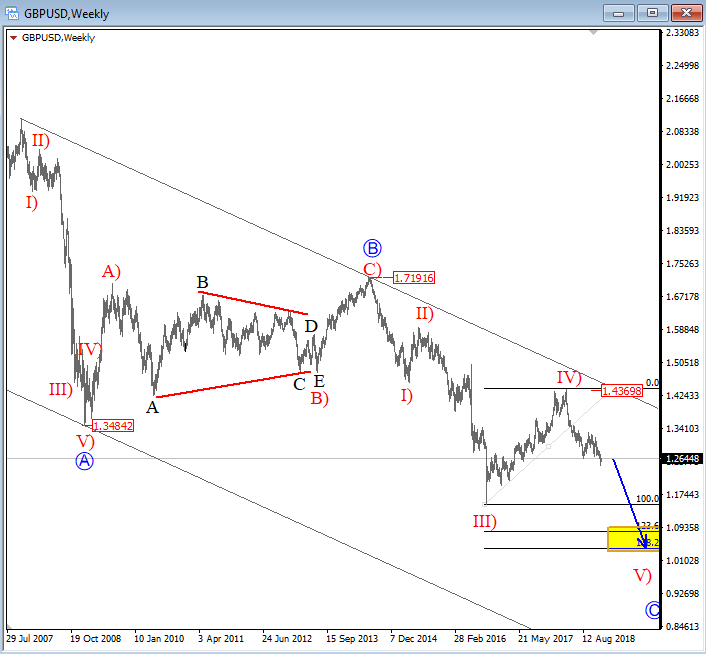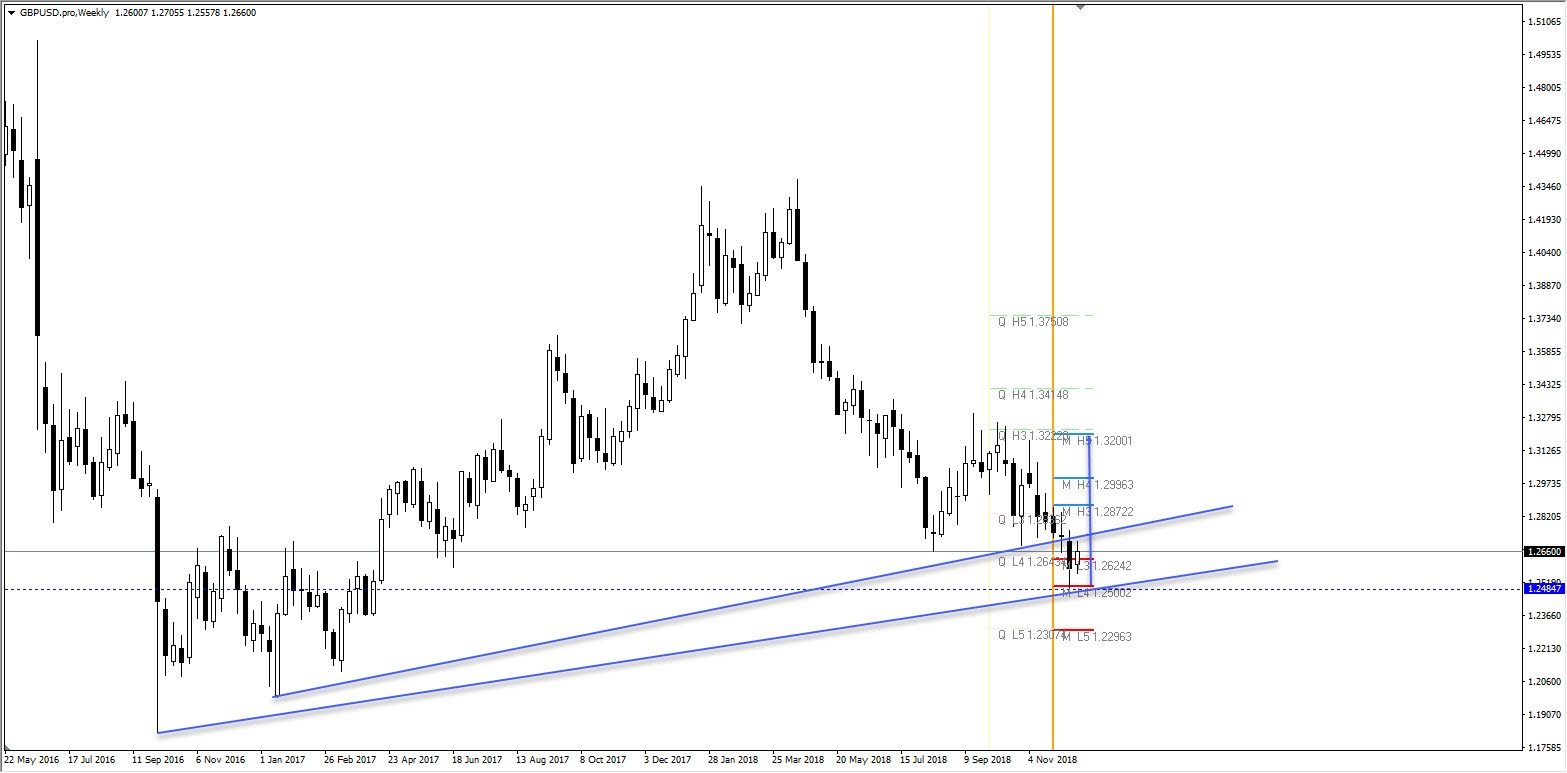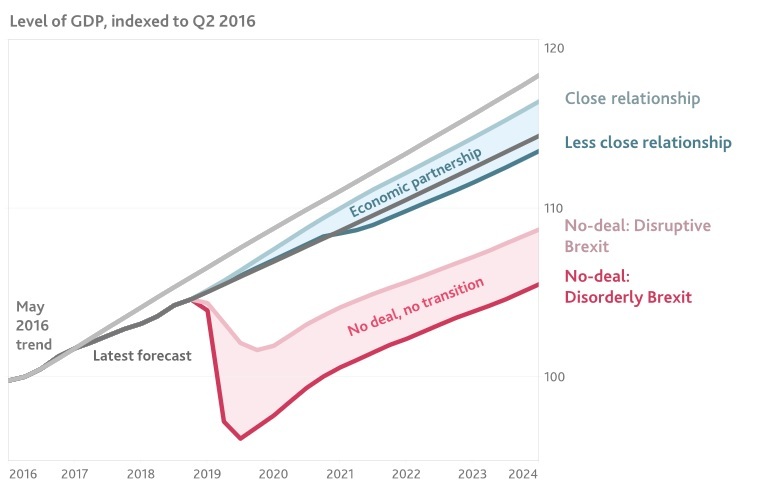- The Brexit uncertainty remains the biggest challenge for UK politics and the biggest drag on Sterling heading into 2019.
- Sterling is expected to weaken at the beginning of 2019 and rebound sharply after the Brexit uncertainty fades away.
- Sterling is set to chart a check mark symbol in 2019.
With the UK government still working its way to the UK parliament with the Brexit agreement approval, the Brexit uncertainty is set to prevail the end of 2018 and the beginning of 2019. The 2019 GBP/USD Forecast is highly dependent on the result of the Brexit deal going forward and with no fundamental bias, all options are still on the table leaving different GBP/USD scenarios all applicable.
Sterling could fall past 1.2000 level that historically frames the bottom and serves as a territory of rebound for GBP/USD in case of hard Brexit. The rational solution for all involved parties in the UK parliament, the UK government and in the EU should be to avoid the scenario of no-deal Brexit that would throw the UK economy and Sterling into disarray with the Bank of England saying the bottom for Sterling would be some 25% lower from here, indicating sub parity levels for GBP/USD. Also, no transition Brexit would represent an adverse scenario for Sterling with falling to the lowest level since 1985 of 1.0700. Such scenarios are still considered unlikely. Should such scenarios materialize, it is almost a sure-shot for traders to experience the deal of the lifetime while buying GBP/USD at historical or/and cyclical lows.
The likelihood of the UK finally making some kind of Brexit deal with the European Union, however low it is now, is still the mainstream scenario for the UK and for GBP/USD.
With Brexit uncertainty weighing, the GBP/USD is expected to test the cyclical low of 1.2200 or even 1.2000 level at the beginning of 2019 before rebounding lower. In fact, this is an opposite scenario of 2018 when GBP/USD appreciated to 1.4377 at the beginning of 2018 just to fall to 1.2477 low at the beginning of December, making 2018 low and the lowest level since April 2017.
As mentioned above, 1.2000 is historically a very importance rebound area for GBP/USD that served as a post-Brexit referendum low also in March 2017. With Sterling approaching the 1.2000 level, it will really take a hard Brexit scenario for GBP/USD to overcome this support level as more and more value investors will ponder of entering the market just for the sake of the bargain buy. Sterling traded below 1.2000 level only for three months in from December 1984 till February 1985 on a chart tracking the history back to 1970.
Regardless of how the economic fundamentals are doing in the UK and the US, the Brexit is likely to drag Sterling lower at the beginning of 2019 before the summertime release of Brexit tensions and subsequent rebound higher. I expect the GBP/USD to chart a check mark in 2019.
External factors helping the check mark type of scenario on GBP/USD to materialize include the dovish Federal Reserve in 2019 delivering only one or two rate hikes in 2019 and perhaps a little more of the European tensions of Italian budget type.
For investors fearing the global economic slowdown to hit the European Union member states first, the UK economy and its currency may become an easy opportunity.
Fundamental analysis
The outlook for the UK economy remains Brexit uncertainty dependent
The UK economy is expected to continue to expand modestly in 2019 and 2020 with the annual GDP growth rate estimated from 1.3% to 1.6% in 2019. The economic growth rate in the UK remains subdued and the lowest among G7 countries as the GDP forecast is still subject to a great deal of Brexit-related uncertainty that is weighing on both business investment and consumers’ spending. The UK government is expected to increase its spending and introduce some short-term tax cuts, but overall Brexit is a drag to the UK economic outlook for 2019.
Although a no-deal Brexit is still not the most likely scenario for the UK economy going into 2019, the UK parliament stands in fierce opposition to the Brexit deal agreed by the government. The ruling Conservative party is divided so profoundly that the UK Prime Minister Theresa May just survived a no-confidence vote from her own party at the beginning of December in a thin victory of 200-117 votes of Conservative party members of parliament.
On the flip side of the story, the UK economy could benefit from a stronger global economy and the competitive value of Sterling that should provide a boost to the UK exports and inbound tourism. The global expansion side of the expectations has a drawback as the Eurozone economy, the UK largest trading partner is slowing down in the escalation of international trade tensions that could dampen global growth in 2019 and beyond.
The UK economic outlook and especially consumer spending should be supported by the UK inflation expectedly stabilizing at around the targeted level of 2% while the UK labor market tightness is continuously expected to press on higher wages.
The UK unemployment rate is expected to remain stuck to a four-decade low of 4.0% in 2019 and the UK wages are seen rising more than 3% over the year, with the consumer spending rising 1.5% over the year as a result.
The baseline scenario is for the Bank of England to keep gradually increasing the Bank rate at a pace of one rate hike a year.
As mentioned above, all of this can easily become a wishful dream in case the UK government no being able to get the Brexit agreement past UK parliament with the UK leaving the European Union in either no transition or even a disorderly Brexit scenario.
The Bank of England estimated four different baseline scenarios for Brexit with the close economic partnership expectedly resulting in the loss of relative GDP of -1.25% to a -3.75% compared to the level from May 2016 while the worst case no-transition, no-deal Brexit could see a relative loss of GDP amounting to -7.75% up to -10.50%.
Modeled Brexit scenarios and relative UK GDP loss
Except for the sharp fall in GDP growth rate the Bank of England said the worst-case "disorderly" Brexit would lead to unemployment of 7.5%, inflation 6.5%, house prices down 30% and Sterling 25% weaker. In the case of Sterling depreciating 25% from the current spot, the GBP/USD would fall below parity to 0.9400, the weakest in Sterling’s 200-year history.
The "disruptive" Brexit would lead to the unemployment of 5.75%, inflation of 4.25%, house prices falling some 14% and Sterling 15% weaker, bringing the exchange rate close to 1985 low of 1.07 against the US Dollar.
The Bank of England stance
The Bank of England is an independent player in the game of Brexit future and the scope of monetary policy is set to be accommodative of whatever the outcome of the political development in the UK.
The Bank of England merit is inflation and looking at the inflation profile of the UK, there are two important factors to look at, the foreign exchange rate development of Sterling and the wage growth development. The FX rate development is clearly Brexit dependent with the worst-case scenario counting with Sterling’s depreciation of 25% while other scenarios count with a lesser extent of Sterling depreciation and lesser impact on inflation.
Sterling depreciation could have a detrimental effect on the level of UK inflation with inflation rate jumping far away from the targeted level of 2%. While the Bank of England would possibly overlook such sharp depreciation as having a temporary effect on inflation, the likely outcome of the monetary policy would result in a short-term easing.
The mainstream scenario though is not based on the assumption of no-deal Brexit and therefore the monetary policy would be far less accommodative with the strategy of one rate hike a year in place. That would mean a rate hike in May 2019 with the policy Bank rate at 1.0% and another rate hike during the course of 2020 bringing the Bank rate to 1.25%.
The monetary policy divergence relative to Fed would still favor the US Dollar, but the relative underperformance of Sterling is still likely to attract much more attention of speculative investors trying to benefit from the Brexit uncertainty fading away once the Brexit deal is sorted.
Technical analysis
GBP/USD monthly chart
The GBP/USD rose from the post-Brexit slump to below 1.2000 level to the cyclical peak of 1.4377 in April of 2018. The GBP/USD subsequently fell gradually towards 1.2660 representing a post-Brexit Fibonacci retracement of 23.6% and fell to a fresh 20-month low of 1.2477 representing also the 2018 low. While GBP/USD is trapped in a downward sloping trend underlined by ongoing Brexit uncertainty, the target of 1.2150 and 1.2000 level persists. Once the Brexit deal is sorted, the GBP/USD is expected to rebound strongly above 1.3000 level. After the break above 1.3000 level is confirmed, targets of 1.3250-1.3500-1.400 come into the play as 1.3250 represent a 20-month moving average and 1.3500 and 1.4000 are both strong psychological levels.
Brexit milestones
- January 2019 - the UK government submits the Brexit agreement to the UK parliament first for debate and then a meaningful vote will take place before January 21.
- Januar-February 2019 - Brexit agreement is passed into laws in the UK while the EU member states are ratifying the Brexit deal at the ministerial meeting. The European Parliament formally ratifies the Brexit deal in a plenary vote.
- March 29, 2019 - Brexit day, the day of the UK formally ends its membership in the European Union and the transition period begins.
- The transition period - this is the time between the UK officially leaving the European Union and the time it finalizes details of our new relationship with the European Union. During the transition period or implementation phase, both the UK and EU will need to finalize details of a new trade deal and businesses will have to adjust to all the changes they will have to make. The period begins when Article 50 ends on March 29, 2019, but for 21 months until December 31, 2020 - 21 months after Brexit day - relationship remains the same.
- December 31, 2020 - according to the Withdrawal Treaty, this is considered the end of the transition period, although that could be changed. The EU chief negotiator Michel Barnier indicated the end of the transition period could be prolonged until December 31, 2022.
- Entering backstop - the Withdrawal Treaty states that if there is no deal at the end of the transition to avoid a hard border with Northern Ireland, then the so-called “backstop” will be automatically enacted. The backstop will keep the entire UK in a “temporary” customs union with the EU, although Northern Ireland will be more deeply integrated into the EU.
GBP/USD Point & Figure Chart
Count 1, established and activated in the second half of 2016, was filled after a slow-motion streak which brought the Sterling to the 1.4200 handle at the end of 2017. The short-lived stumbling from that peak generated a bearish count towards 1.2800 which was almost invalidated with the formation of a second top during 2018, but finally filled with an impressive descent towards 1.2700. Since then, that waterfall dive implies a movement towards 0.9500 in the future. Another case for additional weakness is the clean passing below 1.2700 in the form of a triple-bottom point and figure pattern.

GBP/USD Elliot Wave Analysis
GBPUSD is seen trading in a bigger, three-wave bearish reversal down from 2007 with wave C in play. Wave C is a motive wave, which means it must be structured by five waves. On the chart below, we can see price continuation this year lower into wave V) of C, which can take price towards the Fibonacci extensions of 123.6-138.2 in the months ahead, where pound weakness may slow down.

GBP/USD Camarilla Pivot Point Forecast
 by Nenad Kerkez
by Nenad Kerkez
The GBP/USD formed two ascending trend lines that should spike the price up. A lot of regarding Brexit has already been priced in, so I expect a bounce. 1.2996 followed by 1.3200 should be Q1/Q2 target, especially because the price is rejecting M L3 camarilla pivot point.

Conclusion
The GBP/USD is subject to a high level of uncertainty related to the political development of Brexit. While mainstream scenario indicates the deal to be made in time with the UK leaving the European Union on March 31.2019, there are still some chances of a no-deal Brexit that are likely to weigh on Sterling until the final deal is made.
The GBP/USD is therefore increasingly vulnerable to further fall with 1.2150-1.2000 level representing historical levels of strong support. After the Brexit deal is sorted, much relief of Brexit tensions is expected to result in Sterling appreciation with the extent of the appreciation dependent on both relative performances of policy interest rates of central banks that will affect the benchmark bond yields and the economic performance of the UK economy.
Forecast Poll 2019
| Bullish | 60% |
|---|---|
| Bearish | 36% |
| Sideways | 3% |
| Average Forecast Price | 1.3300 |
| EXPERTS | 1 YEAR |
|---|---|
| FXOpen team | 1.2725 Sideways |
| Dmitriy Gurkovskiy | 1.1685 Bearish |
| Brad Alexander | 1.3800 Bullish |
| ForexGDP Team | 1.1000 Bearish |
| Dmitry Lukashov | 1.3700 Bullish |
| Chris Weston | 1.3200 Bullish |
| Stoyan Mihaylov | 1.5000 Bullish |
| Gregor Horvat | 1.1800 Bearish |
| Chris Svorcik | 1.2000 Bearish |
| Nenad Kerkez | 1.2817 Bullish |
| Joseph Trevisani | 1.3800 Bullish |
| Ed Ponsi | 1.2500 Bearish |
| HotForex Team | 1.4200 Bullish |
| George Hallmey | 1.7360 Bullish |
| Alberto Muñoz | 1.1900 Bearish |
| Yohay Elam | 1.4500 Bullish |
| Walid Salah El Din | 1.2000 Bearish |
| OctaFx Analyst Team | 1.2400 Bearish |
| Jeff Langin | 1.2800 Bullish |
| Scott Barkley | 1.1980 Bearish |
| TD Bank | 1.3400 Bullish |
| ING Bank | 1.4100 Bullish |
| Danske Bank | 1.5060 Bullish |
| National Autralia Bank | 1.4000 Bullish |
| Royal Bank of Canada | 1.2500 Bearish |
| Banque Nationale du Canada | 1.2800 Bullish |
| BNP Paribas | 1.4700 Bullish |
| BMO Capital Markets | 1.3800 Bullish |
| CIBC Bank | 1.4500 Bullish |
| Brown Brothers Harriman | 1.2400 Bearish |
RELATED FORECAST 2019
EUR/USD: At the starting line of a long and bumpy road
USD/JPY: A barometer of global growth and markets
AUD/USD: Collateral damage from the US-China trade war
USD/CAD: CAD comeback on the cards
USD/MXN: Volatility set to remain elevated
Gold: Focus on US real interest rates
Oil: Dwindling demand and substantial supply likely to pressure petrol
The United States Economy and Politics: The return to a bipolar world
The European Union Economy and Politics: Conflict at home
China and International Trade: The crossroads of a great power
Dollar Index: A stumble is not a fall
Note: All information on this page is subject to change. The use of this website constitutes acceptance of our user agreement. Please read our privacy policy and legal disclaimer. Opinions expressed at FXstreet.com are those of the individual authors and do not necessarily represent the opinion of FXstreet.com or its management. Risk Disclosure: Trading foreign exchange on margin carries a high level of risk, and may not be suitable for all investors. The high degree of leverage can work against you as well as for you. Before deciding to invest in foreign exchange you should carefully consider your investment objectives, level of experience, and risk appetite. The possibility exists that you could sustain a loss of some or all of your initial investment and therefore you should not invest money that you cannot afford to lose. You should be aware of all the risks associated with foreign exchange trading, and seek advice from an independent financial advisor if you have any doubts.
Recommended Content
Editors’ Picks

EUR/USD extends recovery beyond 1.0400 amid Wall Street's turnaround
EUR/USD extends its recovery beyond 1.0400, helped by the better performance of Wall Street and softer-than-anticipated United States PCE inflation. Profit-taking ahead of the winter holidays also takes its toll.

GBP/USD nears 1.2600 on renewed USD weakness
GBP/USD extends its rebound from multi-month lows and approaches 1.2600. The US Dollar stays on the back foot after softer-than-expected PCE inflation data, helping the pair edge higher. Nevertheless, GBP/USD remains on track to end the week in negative territory.

Gold rises above $2,620 as US yields edge lower
Gold extends its daily rebound and trades above $2,620 on Friday. The benchmark 10-year US Treasury bond yield declines toward 4.5% following the PCE inflation data for November, helping XAU/USD stretch higher in the American session.

Bitcoin crashes to $96,000, altcoins bleed: Top trades for sidelined buyers
Bitcoin (BTC) slipped under the $100,000 milestone and touched the $96,000 level briefly on Friday, a sharp decline that has also hit hard prices of other altcoins and particularly meme coins.

Bank of England stays on hold, but a dovish front is building
Bank of England rates were maintained at 4.75% today, in line with expectations. However, the 6-3 vote split sent a moderately dovish signal to markets, prompting some dovish repricing and a weaker pound. We remain more dovish than market pricing for 2025.

Best Forex Brokers with Low Spreads
VERIFIED Low spreads are crucial for reducing trading costs. Explore top Forex brokers offering competitive spreads and high leverage. Compare options for EUR/USD, GBP/USD, USD/JPY, and Gold.


 by
by